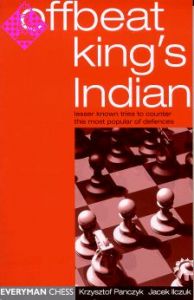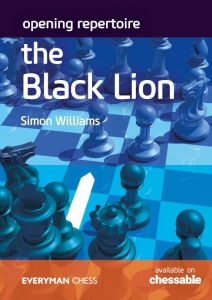Who Dares Wins!
190 Seiten, kartoniert, Everyman, 1. Auflage 2010
Both players are gunning for each other's kings. Whose attack will break through first? This is a typical scenario in chess games. In such tense battles where one slip can be fatal, often it's a case of 'who dares wins'. But it's not enough to throw your pieces up the board and hope for the best. To succeed you need to acquire sophisticated attacking and defensive skills. The good news is that they can easily be learned, remembered and put into practice.
In this book, Lorin D'Costa presents a comprehensive study of opposite-side castling and the crucial techniques needed both in attack and defence. He tackles all the key subjects, including sacrificing, speed of attack, strong and weak defensive formations, when to delay or avoid castling, and much more. Studying this book will allow you to approach these frequent situations with confidence.
- An essential guide to attacking and defending the king
- Includes more than 60 instructive and entertaining games
- Covers the crucial tactical and positional ideas
Lorin D'Costa is an International Master and one of the most rapidly improving players in the UK. He's also an experienced chess teacher who trains some of the UK's top junior players.
Preface 'You know, you just throw your pawns at them or something,' replied one of my students when I asked him what happens when players castle on opposite sides. This confirmed to me just what I had thought: it was not obvious at all what you should do when it does occur!
This book mainly focuses on attacking, as let's face it, we all dream of whipping up an attack and delivering a beautiful checkmate to crown it all off! Of course, how to do this is another matter. Fortunately, it is possible to familiarize yourself with the key attacking formations, plans and themes to help you achieve that wonderful aim of saying 'checkmate' at the end of the game. Conversely, if you are the one being attacked, there are a number of defensive measures you can learn to help beat off the attack, and these are also discussed in this book.
I have tried to include a wide variety of openings to make the book as accessible as possible to all players, because everyone has their pet lines they prefer to play. This variety also helps to demonstrate that it is in fact possible to attack from almost any opening, whether you are White or Black, despite the stigma some openings have of being rather dull.
One thing I noticed when writing this book was that many of the games contained not just one attacking or defensive theme, but several. This meant it was difficult to finalize a chapter list, and to decide which games went where. I definitely recommend taking the time out to go through all the games on a board, in order to become familiar with all the attacking and defensive concepts the games offer.
In short, I hope that you will find this book entertaining and instructive, and that you will take as much pleasure from reading it as I have had in writing it.
Lorin D'Costa
Royston, Hertfordshire, England
December 2009
| Gewicht | 310 g |
|---|---|
| Hersteller | Everyman |
| Breite | 15,2 cm |
| Höhe | 22,8 cm |
| Medium | Buch |
| Erscheinungsjahr | 2010 |
| Autor | Lorin D'Costa |
| Sprache | Englisch |
| Auflage | 1 |
| ISBN-13 | 9781857446296 |
| Seiten | 190 |
| Einband | kartoniert |
| Name | Everyman (former Cadogan) |
|---|---|
| Adresse | 10 Northburgh Street London EC1V 0AT Großbritannien |
| dcaddelman@yahoo.com |
Verantwortlicher Importeuer:
| Name | Schachversand Niggemann |
|---|---|
| Adresse | Schadowstraße 5 48163 Münster Deutschland |
| info@schachversand.de | |
| Internet | www.schachversand.de |
005 Preface
007Sacrifice!
007 Stripping the pawn cover
015 Spicing up the position
022 Trapping the king in the centre
028Piece Power
028 Pawn storm or piece play?
035 Target acquired: training pieces towards the king
039The Battering Ram
039 H is for Hack! Attacking the fianchetto
044 G is for Gamble! Throwing the g-pawn
057 Staring down the barrel: semi-open and open files
065 Attacking unmoved pawn formations
072The Hand Grenade
072 Attacking when the centre is open
076 Opening the centre to your advantage 081Need for Speed: Quick Attacks
081 The straight race
089 Shoot on sight!
094 Time is of the essence
104The Boa Constrictor
104 The snake bite
111 Knowing when to attack
117Typical Attacking Themes
117 The Nd5 sacrifice
127 The Nf5 sacrifice
133 Sacrifices on the h7-square
139 The Greek gift: a bishop sacrifice on h7
143 A rook sacrifice down the h-file
144 The ...Rxc3 exchange sacrifice
148Entering the War Zone
148 Castling into it
150 Don't delay: castle right away!
152 Delaying castling in order to attack
155Guarding the King
155 Don't hit the panic button!
159 Advancing the guard: a3 and ...h6
164 Strong and weak defensive structures
170Follow the Leader
170 How the world champions did it
188 Index of Openings
189 Index of Games
"Who dares wins!", ins Deutsche übersetzt "wer wagt gewinnt!", ist eine thematische Partiensammlung, zusammengestellt von IM Lorin D´Costa und erschienen bei Everyman Chess. Sie enthält 64 interessant kommentierte Partien (für jedes Feld des Schachbretts eine!), die einer vom Autor speziell gezogenen Ordnung unterliegen.
Der Leitgedanke D´Costas ist es, an der folgenden Grundfrage in der Schachpartie orientiert: "Wie führe ich den erfolgreichen Angriff bei unterschiedlichen Rochaden?" Partien zu ordnen und in einer Weise darzustellen, dass der Fokus auf Prinzipien, Grundregeln der Angriffsführung, zu beachtende Stellungsmerkmale etc. gelegt wird. Auf diese Weise erreicht er eine Präsentation von Partien in 10 Kapiteln und stellt dabei die Angriffsmöglichkeiten sowie den erfolgreichen Praxiseinsatz vor. So findet der Leser Beispiele zu Opfern, um die gegnerische Stellung frei zu legen, zu Angriffen bei offenem Zentrum, zum Rochieren in eine Gefahrenstellung, zur Bewachung des Königs und etliche mehr. Im Rahmen der Kommentierung betrachtet der Autor Dinge wie die Ausgangssituation und daraus zu ziehende Schlüsse, Stellungsmerkmale, die anzeigen, dass die Stellung reif ist für eine bestimmte Aktion etc.
Das Werk ist kein Lehrbuch, dieser Anspruch wäre überzogen. Der Leser, der die Partien durcharbeitet, dürfte dennoch klare Lehren daraus ziehen können und das Gefühl für das Angriffsspiel schulen. 52 der Buchpartien stammen aus diesem Jahrtausend, repräsentieren damit das moderne Schach nach dem heutigen Verständnis. Die nur wenigen älteren Partien hätte ich zumeist nicht vermisst, wenn der Autor auf deren Aufnahme zugunsten weiterer aktueller Partien verzichtet hätte, denn sie sind schon oft genug anderen Ortes abgedruckt worden. Der Schwerpunkt liegt aber ganz eindeutig auf modernen Partien, was sehr zu begrüßen ist.
Für mich ist "who dares wins!" ein Kaufkandidat für die Spieler, die ihre Freude am Nachspielen qualifiziert und unterhaltsam kommentierter Partien haben. Sie werden auf ihre Kosten kommen und dabei "durch Beobachtung lernen".
Mit freundlicher Genehmigung
Uwe Bekemann, Deutscher Fernschachbund
www.bdf-fernschachbund.de
**********
In diesem Buch geht IM Lorin D´Costa anhand von 64 ausführlich kommentierten Partien der Frage nach, wie man bei heterogenen Rochaden erfolgreich angreift. In 10 Kapiteln werden die Grundpfeiler der Angriffsstrategie Marke D´Costa genauer vorgestellt. Der junge (Baujahr 84) englische internationale Meister (ELO 2466) hat in seiner Partienauswahl eine gute Balance gefunden, bekannte Partien wechseln sich ab mit relativ unbekannten Schachperlen.
Die 10 Kapitel des Buches lauten:
- Sacrifice!
- Piece Power
- The Battering Ram
- The Hand Grenade
- Need for Speed: Quick Attacks
- The Boa Constrictor
- Typical Attacking Themes
- Entering the War Zone
- Guarding the King
- Follow the Leader
Die Art der Kommentierung fand ich sehr angenehm, der Autor versteckt sich nicht hinter Floskeln oder Variantenmüllhalden sondern bringt kurze prägnante Analysen wo es wirklich wichtig ist. Ansonsten schreibt D´Costa viel über strategische Merkmale die bei einem Angriff wichtig sind, beschreibt typische Motive beim Angriff gegen Fianchetto-Stellungen und stellt unter anderem die wichtigsten taktischen Verfahren im Mittelspiel (Sd5/Sf5 Opfer, usw.) dem Leser vor.
Nebenbei sind die Partien allesamt recht unterhaltsam und natürlich taktisch geprägt, subtile positionelle Manöverpartien wird man hier vergebens suchen.
Der Unterhaltungswert ist also durchaus vorhanden, bleibt nur die Frage, ob das Buch auch für die eigene Spielstärke gewinnbringend eingesetzt werden kann.
Ich meine, wer das Buch gewissenhaft durcharbeitet wird unweigerlich davon profitieren, unabhängig von der Spielstärke, ob als Vorbild oder Inspiration.
Empfehlenswert!
Mit freundlicher Genehmigung
Martin Rieger, April 2010
-
 Nimzo-Indische Geheimnisse19,95 €
Nimzo-Indische Geheimnisse19,95 € -
 Offbeat King's Indian18,50 €
Offbeat King's Indian18,50 € -
 Opening Repertoire: 1 e423,50 €
Opening Repertoire: 1 e423,50 € -
 Opening Repertoire: Black Lion21,50 €
Opening Repertoire: Black Lion21,50 € -
 Offbeat Nimzo-Indian17,95 €
Offbeat Nimzo-Indian17,95 € - Mehr von Everyman



